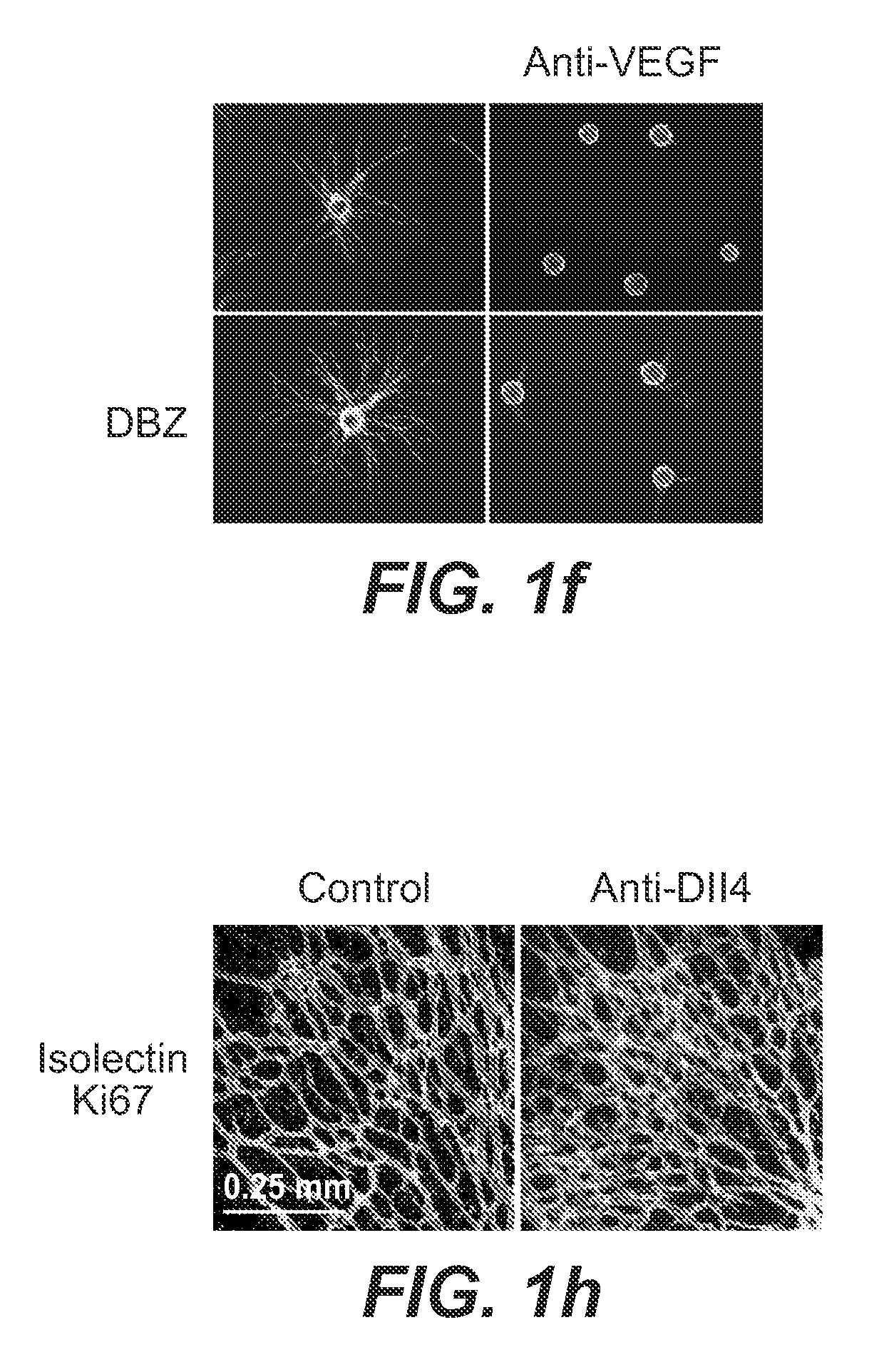Compositions and methods for modulating vascular development
a technology of vascular development and compositions, applied in the field of compositions and methods, can solve the problems of improper endothelial cell differentiation, increased endothelial cell proliferation, improper arterial development in vasculature, etc., and achieve enhanced cdc and/or adcc function, improved effector function, and improved stability
- Summary
- Abstract
- Description
- Claims
- Application Information
AI Technical Summary
Benefits of technology
Problems solved by technology
Method used
Image
Examples
example 1
Materials and Methods
[0360]The following materials and methods were used in the Examples.
[0361]HUVEC fibrin gel bead assay. Details of the HUVEC fibrin gel bead assay have been described (Nakatsu, M. N. et al. Microvasc Res 66, 102-12 (2003). Briefly, Cytodex 3 beads (Amersham Pharmacia Biotech) were coated with 350-400 HUVECs per bead. About 200 HUVEC-coated beads were imbedded in fibrin clot in one well of 12-well tissue culture plate. 8×104 SF cells were plated on top of the clot. Assays were terminated between day 7 and day 9 for immunostaining and imaging. In some experiments, HUVEC sprouts were visualized by staining with Biotin-anti-CD31 (clone WM59, eBioscience) and strepavidin-Cy3. For HUVEC nuclei staining, fibrin gels were fixed overnight in 2% paraformaldehyde (PFA), and stained with 4′,6-diamidino-2-phenylindole (DAPI, Sigma). For Ki67 staining, fibrin gels were treated with 10× trypsin-EDTA for 5 min to remove the top layer SF, neutralized with 10% FBS in PBS, and fixe...
example 2
Generation of Phage Anti-DLL4 Antibodies
[0369]Synthetic phage antibody libraries were built on a single framework (humanized anti-ErbB2 antibody, 4D5) by introducing diversity within the complementarity-determining regions (CDRs) of heavy and light chains (Lee, C. V. et al. J Mol Biol 340, 1073-93 (2004); Liang, W. C. et al. J Biol Chem 281, 951-61 (2006)). Plate panning with naïve libraries was performed against His-tagged human DLL4 (amino acid 1-404) immobilized on maxisorp immunoplates. After four rounds of enrichment, clones were randomly picked and specific binders were identified using phage ELISA. The resulting hDLL4 binding clones were further screened with His-tagged murine DLL4 protein to identify cross-species clones. For each positive phage clone, variable regions of heavy and light chains were subcloned into pRK expression vectors that were engineered to express full-length IgG chains. Heavy chain and light chain constructs were co-transfected into 293 or CHO cells, an...
example 3
Characterization of Anti-DLL4 Antibody
[0370]Epitope mapping of anti-DLL4 Mab YW26.82: Anti-DLL4 Mab 26.82 recognized a binding determinant present in EGF-like repeat number 2 (EGL2) of the human DLL4 extracellular domain (ECD). EGL2 comprises amino acids 252-282 of the human DLL4 ECD. Briefly, DLL4 ECD mutants were expressed as alkaline phosphatase fusion proteins and binding to antibody as assessed. FIG. 5a depicts a schematic representation of a set of DLL4 mutants expressed as C-terminal human placental alkaline phosphatase (AP) fusion proteins. Parentheses indicate DLL4 sequences included in the fusion proteins. 293T cell conditioned media containing the fusion proteins were tested on 96-well microtiter plates coated with purified anti-DLL4 Mab (YW26.82, 0.5 μg / ml). The bound DLL4.AP was detected using 1-Step PNPP (Pierce) as substrate and OD 405 nm absorbance measurement. Mab YW26.82 bound constructs comprising the DLL4 EGL2 domain and did not bind a construct lacking the DLL4 ...
PUM
| Property | Measurement | Unit |
|---|---|---|
| pH | aaaaa | aaaaa |
| temperature | aaaaa | aaaaa |
| ionic strength | aaaaa | aaaaa |
Abstract
Description
Claims
Application Information
 Login to View More
Login to View More - R&D
- Intellectual Property
- Life Sciences
- Materials
- Tech Scout
- Unparalleled Data Quality
- Higher Quality Content
- 60% Fewer Hallucinations
Browse by: Latest US Patents, China's latest patents, Technical Efficacy Thesaurus, Application Domain, Technology Topic, Popular Technical Reports.
© 2025 PatSnap. All rights reserved.Legal|Privacy policy|Modern Slavery Act Transparency Statement|Sitemap|About US| Contact US: help@patsnap.com



